The Pre-Raphaelite Brotherhood was a group of three: Dante Gabriel Rossetti, William Holman Hunt, & John Everett Millais all in their early 20's. Another four joined them later. They are roughly mid-19th c. (1850's onward) which was in the wake of the Oxford Movement. They appreciated Raphael but not the attempt to mechanize his methods and style as if it was the only form of acceptable painting, i.e. the "Raphaelites."
They coupled a renaissance attention to detail with a medieval love of brilliant colour. At the same time they rejected the rising Rationalism of their day known through the Raphaelites in favor of Medieval sense of Truth with a devotion to it. However, their paintings are much like their personal lives, beginning religious and increasingly becoming secular. Many were children to Catholics or High Anglicans, raised in those traditions, shaped by their aesthetic sense, but not fostered enough in their adult life. Whether one was "religious" or not at this time, England had enough remnant Christian influence through Catholic and Anglican history so as to influence these painters. You may also recognize the name Rossetti, his sister Christina wrote the hymn "In the Bleak Midwinter" as well as the children' poem "Goblin Market."
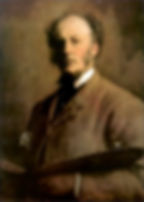
John Millais (1829-1896)
The youngest student to ever enter the Royal Academy Schools at the age of 11. He surpassed his fellow students and became the star of the art school. He later developed a different style that can be seen in his self-portrait to the left. His Pre-Raphaelite stage is below. The Pre-Raphaelites found a philosophical defence for their movement from a poet named Ruskin. After 6 years of non-consummation between Ruskin and his 'wife' Effie, she filed for an annulment. After sitting for some of Millais's paintings they had fallen in love. The two were married soon after. She had a profound effect on his life and work.

Christ in the House of his Parents 'The Carpenter Shop,' 1851 * This is the first and perhaps most famous of the Pre-Raphaelite works that set Britain ablaze with critics, the most famous of which was Charles Dickens the novelist. Mary was called "ugly," the dirt and blood and vein details were thought too gritty for art depicting religious content.
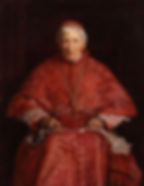
John Henry Newman, 1881
This portrait is used more than almost any other photo or painting for Bl. John Henry Newman.

Eve of St. Agnes, 1863
* Based on a Keats poem which is based on an old folk superstition that a young lady could see her future husband if she performed a series of rites on First Evensong (Eve) of St. Agnes' Feast day.

Vale of Rest, 1858
* The Oxford Movement helped cultivate Anglican sisterhoods but many also became Catholic. These seem to be Catholic.
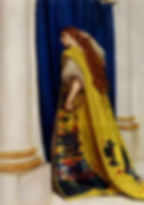
Esther, 1865
* From The Book of Esther.
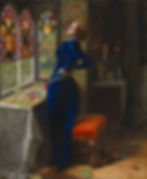
Mariana, 1851
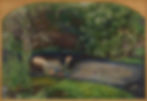
Ophelia, 1851-1852
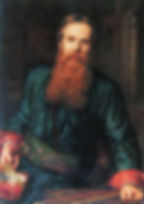
William Holman Hunt (1827-1910)
Hunt was baptized an Anglican and had special ties to St. Paul's Cathedral London [pic] and to St. Mark's English Church in Florence, Italy [pic]. When his wife died he purchased a chalice to be used at The Holy Eucharist with her name inscribed on it. His work "Light of the World" was put into Keble College, Oxford and he he even painted a copy in his 70's to be placed in the main chapel of St. Paul's. He is buried there. He made multiple trips to The Holy Land to better his detail and accuracy (e.g. Christ and Two Marys or Scapegoat) but wasn't so Rationalistic as to think that precluded the use of Biblical imagery and Medieval metaphor. He seems to have been something of a character, a smart aleck, and one of the few Pre-Raphaelites who stuck to the style till his death. His 1867 self-portrait is on the left.

The Light of the World, 1851-53
* A famous piece based on Revelation 3:20, "Behold, I stand at the door and knock; if any one hears my voice and opens the door, I will come in to him and eat with him, and he with me."

Finding the Saviour in the Temple [Luke 2:41-52], 1854-60
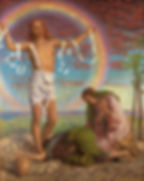
Christ and Two Marys, 1847

The Scapegoat, 1854-56
[An excerpt from Hunt's autobiography on this piece. This is the Scapegoat from Leviticus 16, which allows John the Baptist to call Jesus the "Lamb of God" and for the Crucifixion and thus The Mass to be considered the New Day of Atonement]
Gambart, the picture-dealer, was ever shrewd and entertaining. He came in his turn to my studio, and I led him to The Scapegoat. "What do you call that?" "The Scapegoat." "Yes; but what is it doing?" "You will understand by the title, Le bouc expiatoire." "But why expiatoire?" he asked. "Well, there is a book called the Bible, which gives an account of the animal. You will remember." "No," he replied, "I never heard of it." "Ah, I forgot, the book is not known in France, but English people read it more or less..."
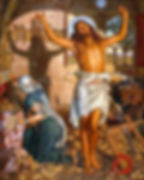
The Shadow of Death, 1870-73

Isabella, or the Basil Pot, 1818 * Based on a Keats poem where a young woman's love is killed and she finds his head in a basil pot, which in turn is based on an older tale called Decameron. Pleasant.
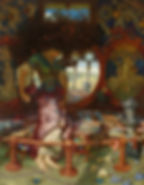
The Lady of Shalott, 1905
* Based on Tennyson's poems of Arthurian legend, a common medieval trope for the Pre-Raphaelites.

Dante Gabriel Rossetti
A lover of his namesake Dante Aligheri, as well as St. Thomas Malory's L'Morte D'Arthur he based many of his paintings on Medieval themes. He was as much a poet as an artist. As a boy of 15 he saw the effects of the Oxford Movement on the Anglican Church his family frequented. As his life progressed he seemed to fall into drug abuse and then lost his wife from an overdose. He moved away and filled his home with eccentric pets like wombats or toucans that wore cowboy hats rode llamas around his dining room. He is buried at All Saints [pic] in Birchington, Kent. His 1847 self-portrait is on the left.

Ecce Ancilla Domini (Behold the Handmaid of the Lord), 1850 * This was his first big release as part of the Pre-Raphaelite Brotherhood. Critics called his angel "Insipidity itself."
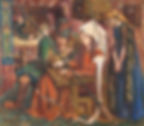
The Tune of the Seven Towers, 1857
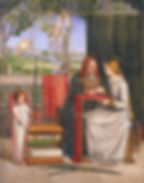
The Girlhood of Mary Virgin, 1849
* His mother sat for St. Anne, his sister Christina for St. Mary.

How Sir Galahad. Sir Bors, and Sir Percival were fed with the Sanc Grael; [i.e. Holy Grail] But Sir Percival's Sister Died Along the Way, 1864

Proserpine [aka Persephone with her pomegranate], 1874

Sir Tristram and la Belle Ysoude drink the potion, 1862-63
While the Pre-Raphaelites in their personal lives seemed far off from faithful Catholics, or even Anglicans for that matter, their work is deeply reflective of a culture that still had fragments of Catholicism in the water, and a Britain that had a feverish excitement at reviving those elements shortly after The Oxford Movement. Such elements of Catholicism are what The Ordinariate hopes to collect and graft onto the "Roman Stalk" that they might survive all time as a Testament to The God who is Beauty Incarnate.
